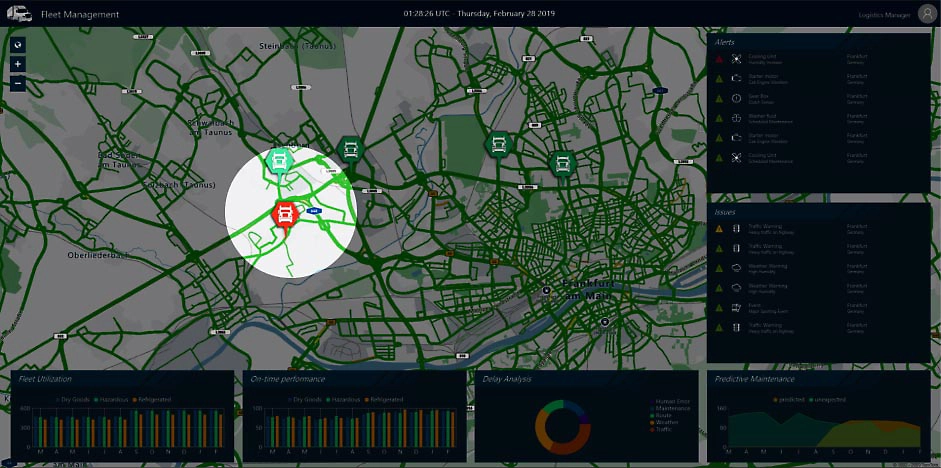When you have a fleet of anything, it is important to know the status and locations of all members of that fleet at all times. This is where the disciplines of Fleet Management and Fleet Tracking are required for success. Azure and Azure maps offer all of the tools your team needs to build a comprehensive and compliant Fleet Management Tracking solution, customized for your unique requirements.
What Is Fleet Management Tracking?
Fleet tracking generally includes a technological system to monitor status, report location and manage maintenance schedules of their vehicles. Tracking fleets relies heavily on using a global positioning system (GPS) and real-time data reporting with connectivity, even where network access may be scarce. This stream of data enables companies to monitor the status and locations of vehicles making up fleets and ensure the health and safety of their employees.
Companies that depend on accurate fleet tracking include those operating in logistics, transportation, and similar industries.
The Challenges of Managing Fleet Locations
As you can imagine, managing a fleet comes with challenges. Several potential obstacles associated with fleet management include:
- Not Having Real-Time Data: Because fleets are often on the move, fleet managers must have access to real-time data. Without data coming through in real time, even the best decisions can happen too late.
- Information Overload: Depending on a fleet’s size or the amount of generated data, fleet managers sometimes find themselves dealing with information overload. Effective data management is helpful to combat this problem.
- Inaccurate Data: Using a low-quality data solution can lead to inaccurate data. As you can imagine, data inaccuracies can result in late deliveries, vehicles traveling in unmaintained conditions, and unoptimized routes.
- A Lack of Integrations: Using a fleet management system is helpful. However, systems that can’t integrate well or at all with commonly used work-related programs and services can create extra work.
The Benefits of a Properly Managed Fleet System
Fleet management tracking offers many benefits for companies, drivers, and customers, including:
- Lower fuel, maintenance, and insurance costs
- Maximized fleet productivity
- Less downtime
- Fewer accidents & higher regulatory compliance
- Reduced instances of theft
- On-time deliveries
- More informed fleet decision-making
Azure Maps and APIs: A Complete Fleet Management System

Whether your company’s fleet contains just a few or several thousand vehicles, fleet management tracking can make business operations easier than ever. Azure Maps offers the building blocks for anyone to build a fleet management system. Here’s a closer look at Azure Maps’ features for complete fleet clarity.
Geocoding and Reverse Geocoding
Geocoding is the process of translating text-based address descriptions into geographical coordinates. This includes everything from a standard street address to a general area name. There is also reverse geocoding, where geographical coordinates are converted into accurate text-based descriptions.
These features are incredibly helpful for tracking fleet locations or what they’re hauling into easy-to-understand addresses, coordinates, or place names.
Azure Maps also offers reverse geocoding, enabling conversions of GPS points into road names, cities, states, or customized outputs.
Integrations with Azure Services and APIs
Another stand-out reason to choose Azure Maps for fleet management tracking involves its many integrations. Azure Maps is useful in a wide array of mobile and web-based fleet tracking applications and bundling Azure Maps with other Azure tools unleashes the true potential to deliver major wins for your business or enterprise.
Consider integrating Azure Maps with other Azure tools, such as:
- Azure Logic Apps: Automate time-consuming fleet-related workflows by integrating Azure Logic Apps with Azure Maps. Companies and enterprises also combine these tools in our toolkit to receive real-time updates about vehicles entering or leaving geofenced areas. Enforce safe driving by monitoring drivers’ speed and other behaviors from anywhere.
- Azure IoT Hub: Enjoy the convenience and peace of mind of Azure Maps combined with Azure IoT Hub for real-time fleet management tracking. Combining this tool with Azure Maps also lets you visualize overall routes.
- Power Bl: Experience an easier way to create fully interactive dashboards, helping you manage and maintain fleets by keeping an eye on fuel consumed, distances traveled, maintenance records, and other critical metrics. Seamlessly integrate data from Azure Maps to add route and vehicle information from these APIs into your dashboards.
- Azure Synapse Analytics: Gain valuable and detailed insights from your fleet’s data, including previously uncovered takeaways. Have this information displayed visually in a spatial manner to present fleet management tracking data to other teams and departments in a manner that’s understandable for everyone.
- Azure App Service: It doesn’t have to take a large developer team or a million-dollar budget to create easy-to-use and data-driven apps. Using Azure Maps data, your team can create and develop customized and intuitive fleet management systems.
- Azure Digital Twins: Model and bring to life scalable digital environments that improve operations and yield untapped insights. Integrating Azure Digital Twins with Azure Maps offers a complete solution for managing your fleet virtually like never before.
- Azure Time Series Insights: This tool lets your team analyze critical time-series data concerning your fleet. Combining Azure Time Series Insights with Azure Maps provides context to time-series data as you visualize vehicle routes and information in real-time.
Whether your business uses mobile, web-based apps, or both, Azure Maps offers application program interfaces (APIs) to build solutions that provide superior insights into vehicle routing, asset tracking, and geolocation. Azure Maps includes an extensive set of APIs for in-depth data processing and analysis of fleet locations, including:
- Waypoint Optimization: Using route-based data, route waypoint optimization provides waypoint-optimized routes for time and resource-efficient transportation.
- Matrix Routing: Calculates route summary matrixes defined by origin and destination locations using async or sync POST requests.
- Snap to Road: From speed limit maps to fleet route patterns, Snap to Road API creates user-friendly and intuitive visual map paths.
Explore the Azure Maps platform today and start building for free. Integration with a trusted maps platform plays a vital role in the continued success of fleet companies. Azure Maps provides the building blocks to build a complete fleet management tracking solution.
The Azure Toolkit, including Azure Maps, Azure Digital Twins, Azure IoT Hub, and other Azure programs can help your developers and analysts leverage real-time data for fleet locations, routes, and assets. In turn, your business has the valuable information necessary for on-time deliveries and satisfied customers.


